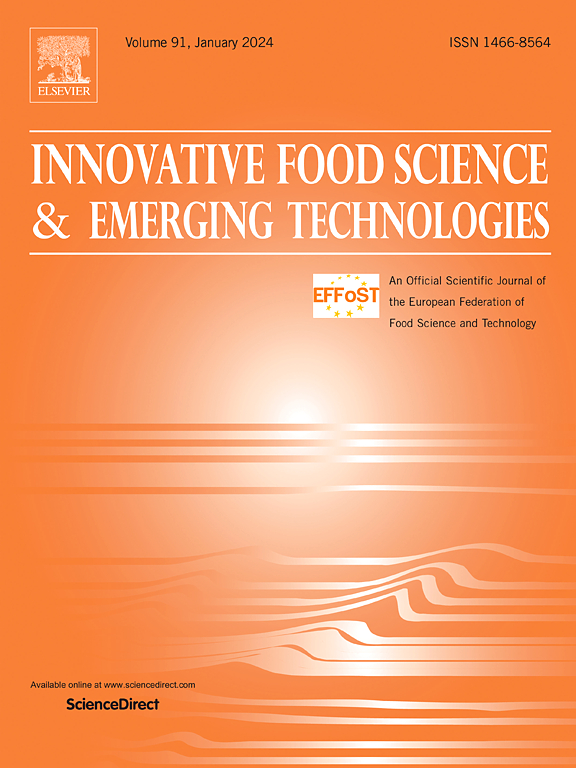Improving the drying efficiency, quality attributes, and lycopene bioaccessibility (in vitro) of tomato puree using refractance-window hybrid drying
IF 6.3
1区 农林科学
Q1 FOOD SCIENCE & TECHNOLOGY
Innovative Food Science & Emerging Technologies
Pub Date : 2025-03-29
DOI:10.1016/j.ifset.2025.104014
引用次数: 0
Abstract
Tomato (Solanum lycopersicum) is a globally important vegetable with high nutritional value but a short shelf life. This study evaluated three RW hybrid drying technologies—infrared-assisted (RW + IR), vacuum-assisted (RW + V), and forced air-assisted (RW + FA)—for drying whole tomato puree. The effect of the distance of infrared lamps, vacuum pressures and air temperature on drying rate, energy consumption, physicochemical properties, lycopene content and bioaccessibility were assessed. RW demonstrated advantages only in color preservation, showing the least ΔE. RW + V best preserved lycopene content and had the lowest hygroscopicity of all the evaluated technologies. RW + HA did not show significant improvements over RW. Meanwhile, RW + IR reduced drying time by 12.5–68.8 %, increased drying rates by up to 220.3 %, and improved energy efficiency by 41.9 % compared to RW. Additionally, compared with all the hybrid technologies, RW + IR exhibited the lowest water activity (0.17) and maintained the greatest total polyphenol content, antioxidant activity/capacity, and lycopene bioaccessibility (34.1 %). The desirability model confirmed that RW + IR offers the best drying advantage over RW, with 80 °C and 15 cm being the ideal drying conditions. These results suggest that RW hybrid drying technologies, particularly RW + IR, can enhance tomato powder production while improving both quality and shelf life.
利用折射窗杂交干燥技术提高番茄泥的干燥效率、品质属性和番茄红素的体外生物可及性
番茄(Solanum lycopersicum)是一种营养价值高但保质期短的全球重要蔬菜。本研究评估了红外辅助(RW + IR)、真空辅助(RW + V)和强制空气辅助(RW + FA)三种RW混合干燥技术对整个番茄酱的干燥效果。考察了红外灯距离、真空压力和空气温度对干燥速度、能耗、理化性质、番茄红素含量和生物可及性的影响。RW仅在颜色保存方面表现出优势,表现最少ΔE。RW + V技术保存番茄红素含量最好,吸湿性最低。与RW相比,RW + HA没有明显的改善。与RW相比,RW + IR干燥时间缩短了12.5 - 68.8%,干燥速率提高了220.3%,能源效率提高了41.9%。与所有杂交技术相比,RW + IR的水分活性最低(0.17),总多酚含量、抗氧化能力和番茄红素生物可及性最高(34.1%)。可取性模型证实,RW + IR比RW提供了最佳的干燥优势,80°C和15厘米是理想的干燥条件。综上所述,RW + IR混合干燥技术,尤其是RW + IR干燥技术,在提高番茄粉产量的同时,还能提高番茄粉的品质和保质期。
本文章由计算机程序翻译,如有差异,请以英文原文为准。
求助全文
约1分钟内获得全文
求助全文
来源期刊
CiteScore
12.00
自引率
6.10%
发文量
259
审稿时长
25 days
期刊介绍:
Innovative Food Science and Emerging Technologies (IFSET) aims to provide the highest quality original contributions and few, mainly upon invitation, reviews on and highly innovative developments in food science and emerging food process technologies. The significance of the results either for the science community or for industrial R&D groups must be specified. Papers submitted must be of highest scientific quality and only those advancing current scientific knowledge and understanding or with technical relevance will be considered.

 求助内容:
求助内容: 应助结果提醒方式:
应助结果提醒方式:


